What Are The 17 Sales Tools For B2B To Build a Pipeline?

Key Highlights
SmartCue delivers interactive demos that engage buyers and speed up presales.
Salesforce, HubSpot, Zoho, and Pipedrive cover CRM needs from startups to enterprises.
ZoomInfo, LinkedIn Sales Navigator, and Apollo supercharge prospecting with rich data.
PandaDoc simplifies proposals and contracts with templates and e-signatures.
Vidyard and Mailsuite make outreach personal and trackable.
Sales acceleration platforms like Artisan and Vivun bring AI to outbound and presales.
Saleo enables polished, data-driven live demos.
Nextiva and Zoom keep communication seamless across calls, video, and meetings.
Calendly eliminates scheduling friction and makes booking effortless.
They say a great salesperson can sell ice to an Eskimo, but in today’s B2B world, even the best reps struggle without the right tools.
B2B sales isn’t just about relationships and persistence anymore. It’s about speed, precision, and strategy. Every step, from prospecting to closing, is now a data-driven process, and the teams that use the right tools are the ones winning deals. Without them, you’re running uphill while your competitors are cruising on autopilot.
The problem? The market is flooded with thousands of sales tools, each promising to revolutionize your process. But which ones actually deliver?
We have cut through the noise to highlight the most powerful B2B sales tools that help teams generate more leads, close deals faster, and maximize revenue.
What Are the 17 Best B2B Sales Tools (and Who Actually Needs Them)?
Every salesperson knows the feeling: your inbox is overflowing, your CRM reminders are piling up, and you’ve got so many tabs open, you can’t even remember which one you actually need. That spreadsheet you spent hours perfecting? Somehow, it’s only made things more complicated.

But the right tools? They make selling smoother, faster, and way more effective. They help you engage leads before they ghost, automate what slows you down, and give you the data to close smarter.
This list isn’t just another roundup of generic sales software. These are the tools that actually help sales teams cut through the clutter, win more deals, and stay sane in the process. Let’s get right into it.
1. SmartCue – The Presales Demo Advantage

SmartCue is a no‑code presales collaboration software that helps presales teams create interactive, personalized product demos in minutes. Unlike static slide decks or time‑intensive live setups, it delivers self‑serve, data‑driven demos that engage prospects and accelerate deals.
Why SmartCue Outperforms Other Demo Tools
Fastest Time to Value: Launch a polished, interactive demo in minutes.
Actionable Insights: Analytics reveal exactly how prospects interact with demos.
Scalable Without Complexity: Supports solo reps to enterprise presales teams with ease.
What Users Say
Consistently rated 4.8★ on Product Hunt and 4.8★ G2 for speed, simplicity, and versatility.
Teams report creating first demos within minutes, replacing lengthy live prep cycles.
Adopted easily across sales, presales, marketing, and customer success teams.
If your team is still juggling clunky slides and scattered demo environments, SmartCue is the fastest way to turn presales chaos into polished, revenue‑ready demos.
Try it free for two weeks and see the difference before your next pitch.
Pricing:
Free trial - 14-day test period
Essential – $99/user/year
Growth – $300/user/year
Enterprise – Custom
2. Salesforce CRM: Cutting-edge Solution for Lead Management
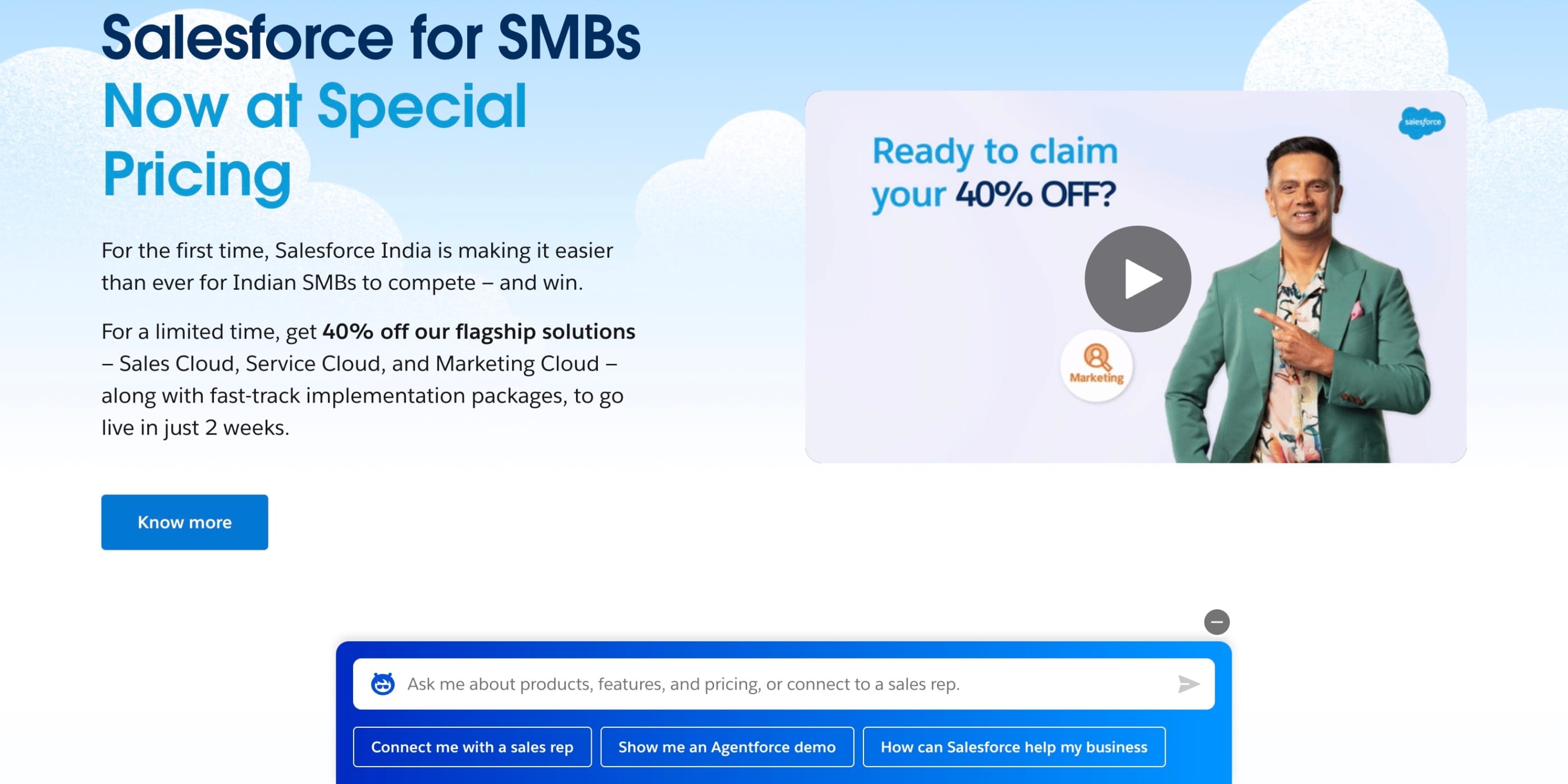
Salesforce is the industry‑leading CRM that keeps every lead, interaction, and opportunity organized in one place. It empowers presales teams to track engagement, automate workflows, and forecast deals with precision. With real‑time dashboards and deep analytics, it turns messy pipelines into actionable strategies.
Why Salesforce is a Good Choice:
Highly customizable for any industry or workflow
Robust analytics and sales forecasting
Extensive third‑party integrations
What To Look Out For:
Steep learning curve for new users
High cost, especially for smaller teams
Pricing:
Starter Suite – $25/user/month
Pro Suite – $100/user/month
Enterprise – $165/user/month
3. PandaDoc: For Automating the Proposal Lifecycle

PandaDoc streamlines proposal creation, approvals, and e‑signatures so your presales team can focus on selling instead of formatting. With customizable templates, pricing tables, and real‑time document tracking, it shortens the sales cycle and boosts professionalism.
Why PandaDoc is a Good Choice:
Automates proposal creation and approvals
Built‑in e‑signature and document tracking
Easy integration with CRMs and payment platforms
What To Look Out For:
Limited offline functionality
Template customization can feel restrictive
Pricing:
Starter – $19/seat/month
Business – $49/seat/month
Enterprise – Custom pricing
4. ZoomInfo: For Prospecting and Creating Targeted Outreach

ZoomInfo gives presales teams instant access to verified B2B contact and company data, plus buying intent insights. It enables smarter targeting, personalized outreach, and faster pipeline growth by ensuring you focus only on high‑potential leads.
Why ZoomInfo Is a Good Choice:
Massive, accurate database of decision‑makers
Strong sales intelligence and lead‑scoring tools
Integrates seamlessly with popular CRMs
What To Look Out For:
Expensive for small teams
Some data can be outdated or incomplete
Pricing:
Free trial available for teams to test out commitment-free.
Sales → Custom pricing
Marketing → Custom pricing
Talent → Custom pricing.
5. Vivun- For AI-driven Sales Acceleration
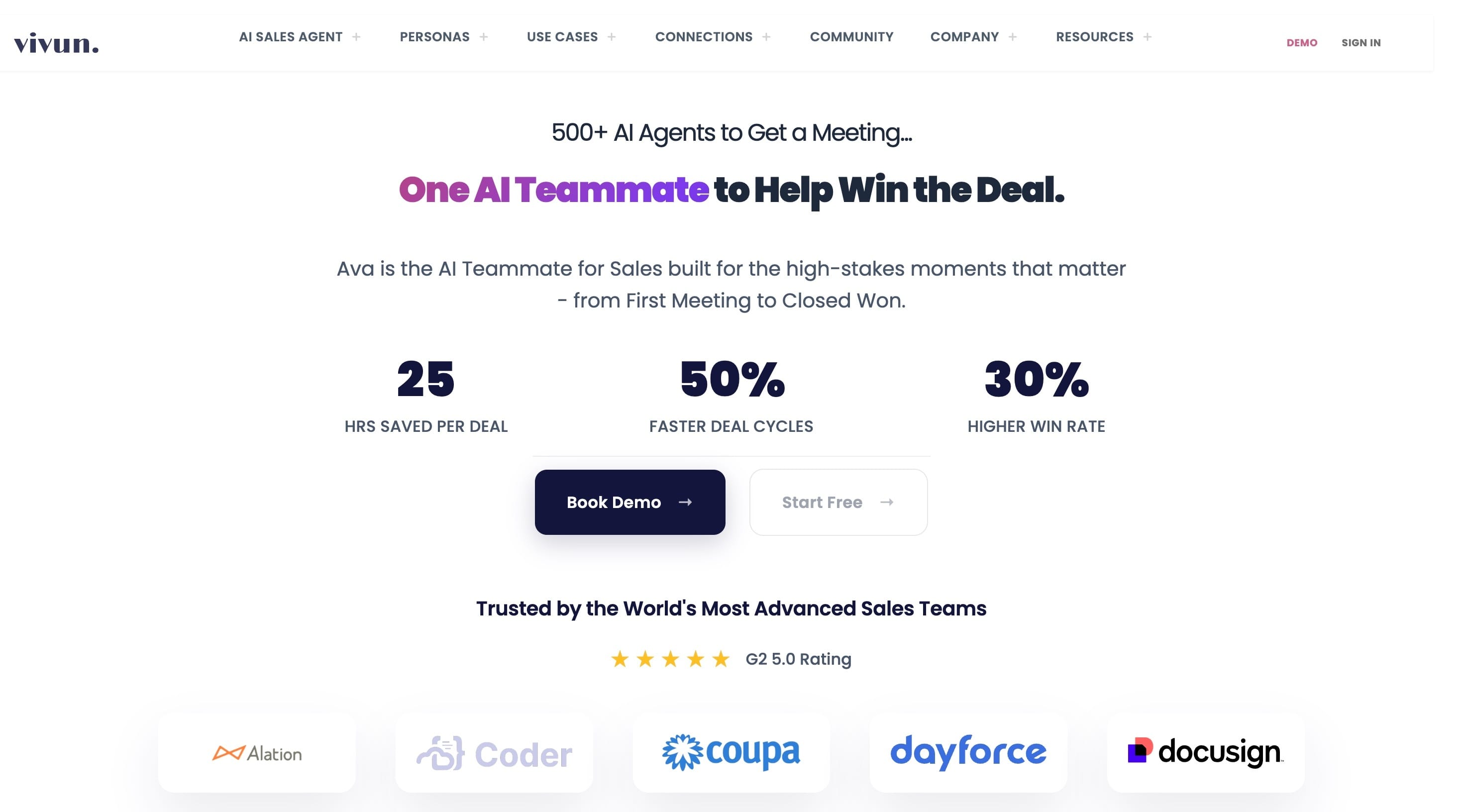
Vivun is an AI‑powered platform that elevates presales from support to strategy. It optimizes deal prioritization, capacity planning, and product alignment, helping teams close high‑value opportunities faster.
Why Vivun Is a Good Choice:
Hero Score quantifies presales impact on revenue
AI insights improve deal prioritization and resource allocation
Strengthens collaboration between sales, presales, and product teams
What To Look Out For:
Higher cost may challenge smaller teams
Requires change management to fully leverage features
Pricing:
Free → Up to 5 spaces
Enterprise → Custom Pricing
6. Saleo- For Incorporating Overlays Into Your Live Product
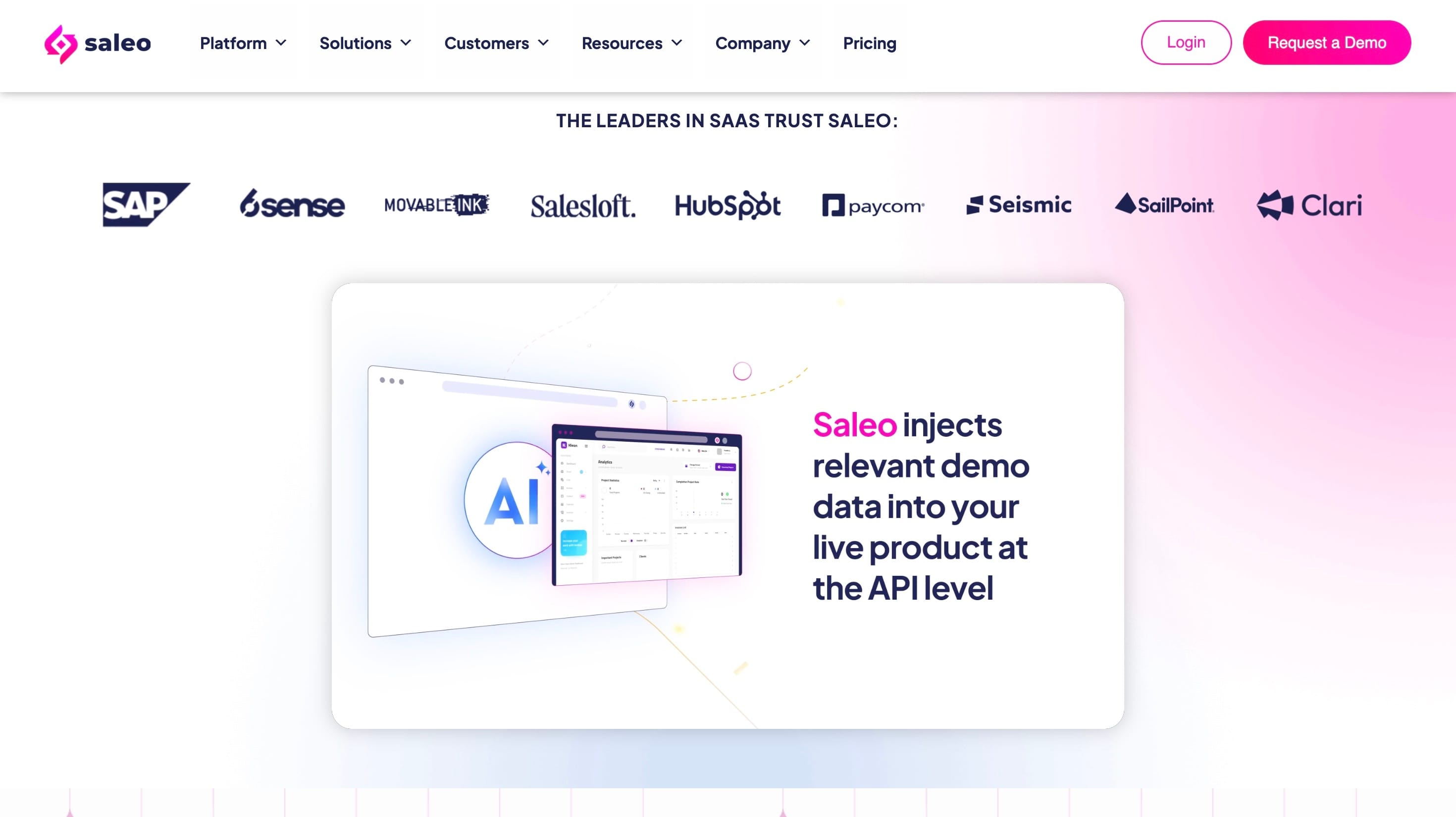
Saleo lets you deliver fully personalized, data‑rich live demos using your real product. By adding interactive overlays and controlling the data shown, it turns every demo into a polished, conversion‑ready experience.
Why Saleo Is a Good Choice:
Creates authentic, customizable live demos
Full control over demo data for security and accuracy
Eliminates the need for multiple demo environments
What To Look Out For:
Initial setup and integration can be time‑intensive
Learning curve for non‑technical team members.
Pricing:
Saleo does not publish its pricing publicly. Costs are typically customized based on team size, use cases, and feature requirements.
7. Mailsuite: For Monitoring Email Engagement
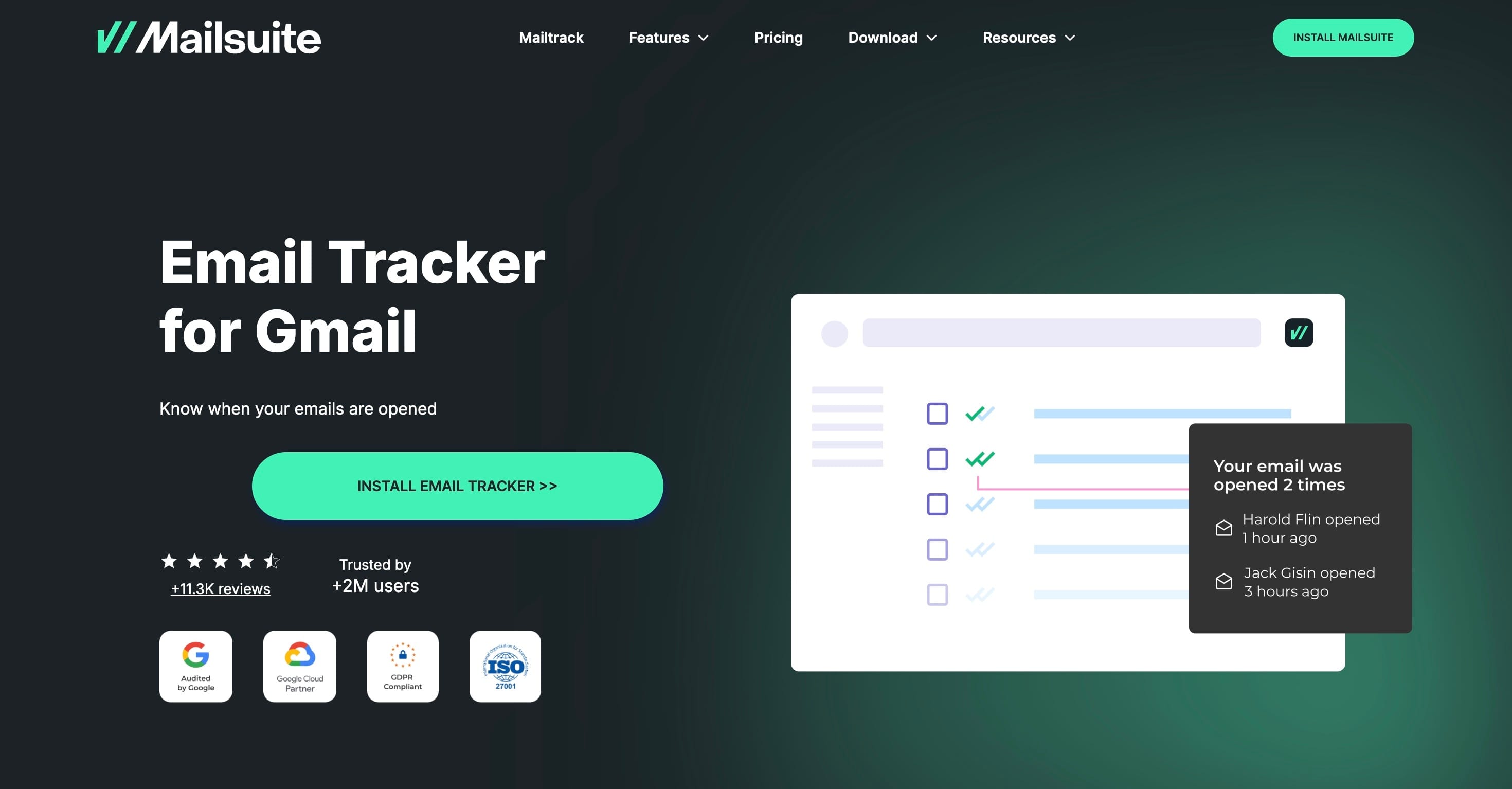
Mailsuite tracks opens, clicks, and replies so your presales team knows exactly when leads engage. With this insight, you can time follow‑ups perfectly and prioritize prospects who are ready to move.
Why Mailsuite Is a Good Choice:
Real‑time tracking for opens, clicks, and replies
Enhances lead prioritization and follow‑up timing
Easy integration with popular CRMs
What To Look Out For:
Limited A/B testing features
Can be costly for smaller teams
Pricing:
Free – $0/user/month
Advanced – $9.99/user/month
8. Artisan – All-in-One AI-Powered Outbound Sales

Aritsan is a comprehensive AI-powered sales platform designed to streamline outbound prospecting and engagement. Its AI BDR, Ava, automates up to 80% of repetitive outbound tasks like research, email sequencing, and follow-ups, freeing reps to focus on relationship-building and closing.
Why Artisan Is a Good Choice:
AI-driven automation handles outreach, lead research, and engagement.
Hyper-personalized campaigns via the Personalization Waterfall algorithm.
Access to hundreds of millions of enriched global leads.
Built-in email warm-up to improve deliverability and inbox placement.
What To Look Out For:
Pricing is fully custom and may not suit smaller teams.
AI-driven personalization may require oversight to maintain brand voice.
Pricing:
Custom pricing based on team size and requirements. Contact sales for a quote.
9. HubSpot CRM – User-Friendly CRM for Small Teams

HubSpot CRM is one of the most popular choices for businesses that want an easy-to-use platform for managing customer interactions, tracking deals, and aligning sales with marketing. With a clean interface and a generous free plan, it’s a strong option for startups and small teams looking to organize their pipeline without heavy complexity.
Why HubSpot CRM Is a Good Choice:
Intuitive dashboard that makes tracking deals and contacts simple.
Built-in email tracking to monitor opens, clicks, and responses.
Seamless integrations with marketing automation and third-party tools.
Robust free plan that supports small businesses.
What To Look Out For:
Advanced features are locked behind higher-tier plans.
May not scale as effectively for very large or enterprise teams.
Pricing:
Sales Hub Starter – $15/user/month
Starter Customer Platform – $15/user/month
Sales Hub Professional – $90/user/month
Sales Hub Enterprise – $150/user/month
10. Zoho CRM – Affordable CRM With AI Assistance
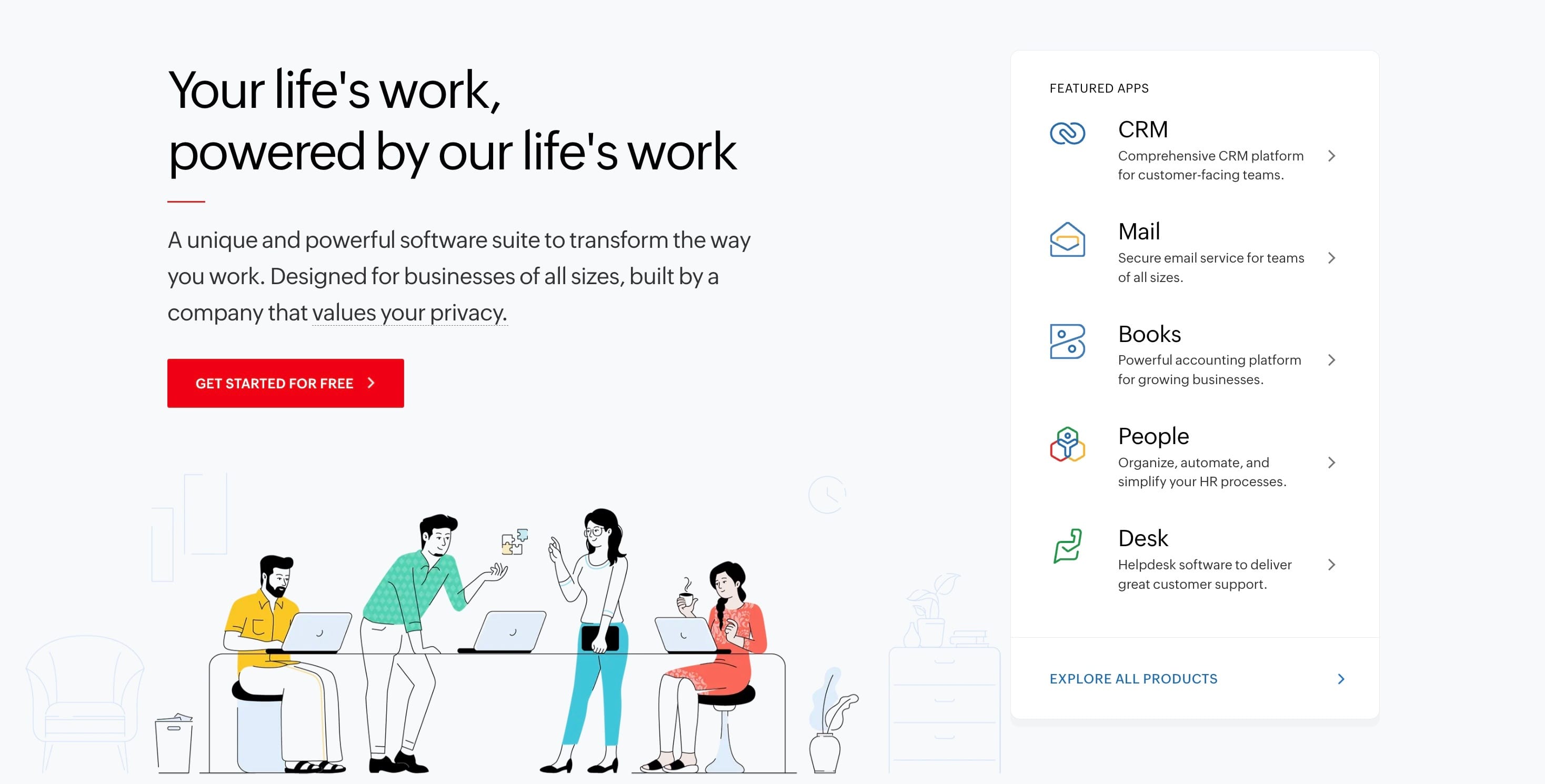
Zoho CRM is a budget-friendly yet feature-rich solution designed for small and mid-sized businesses. It combines AI-powered insights, lead management, and automation to streamline sales processes. With extensive customization and integration options, Zoho offers strong value without the high price tag.
Why Zoho CRM Is a Good Choice:
AI-driven sales assistant for smarter lead prioritization.
Workflow automation to save time on repetitive tasks.
Detailed reporting and analytics for sales performance.
Flexible integrations and no-code customization.
What To Look Out For:
Interface can feel less polished compared to higher-end CRMs.
Some advanced features require higher-tier plans.
Pricing:
Standard – $14/user/month
Professional – $23/user/month
Enterprise – $40/user/month
Ultimate – $52/user/month
11. LinkedIn Sales Navigator – Advanced Prospecting on LinkedIn
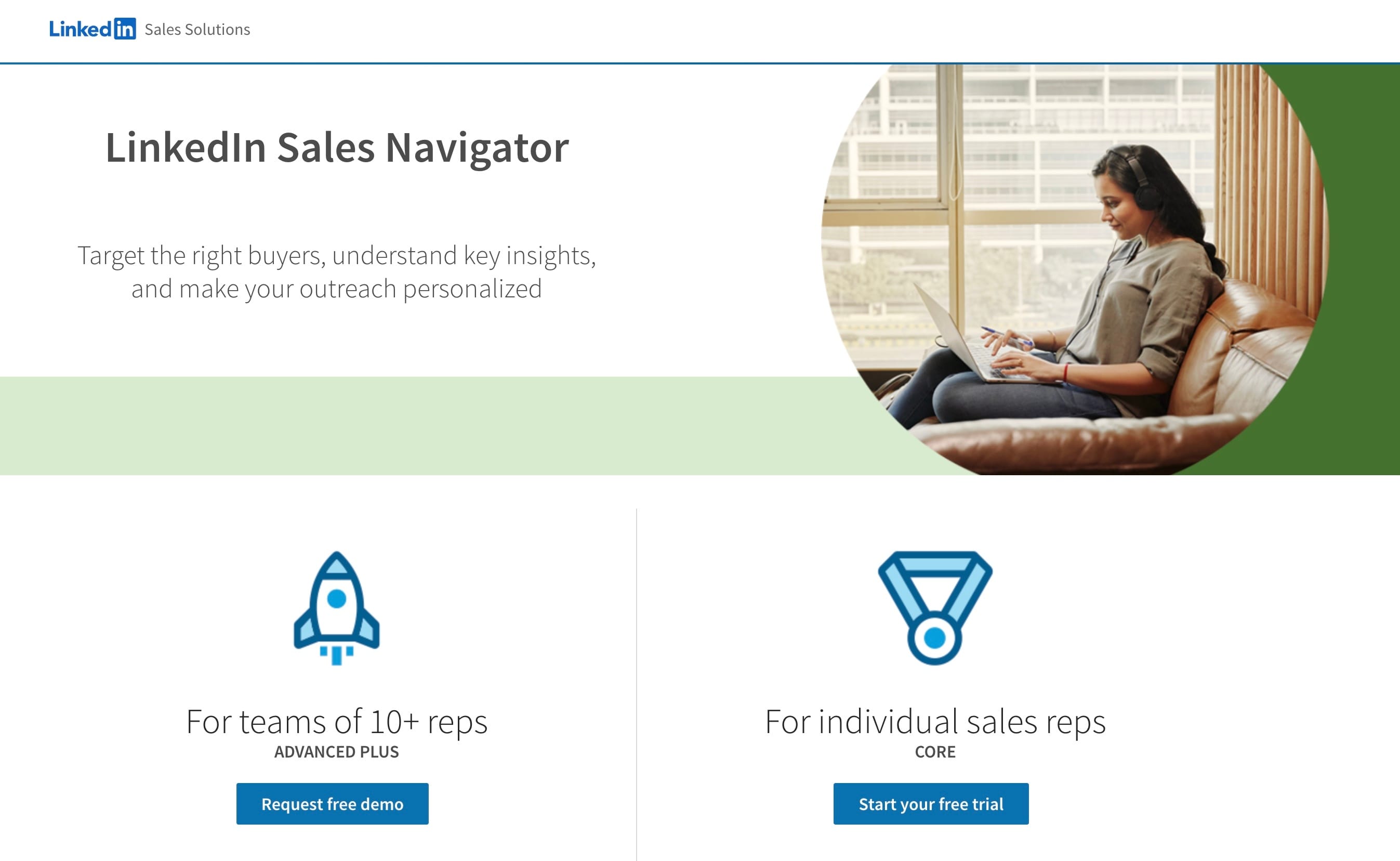
LinkedIn Sales Navigator leverages LinkedIn’s vast professional network to help B2B sales teams identify, connect, and engage with decision-makers. It’s a go-to tool for account-based selling, offering advanced filters, AI-driven recommendations, and direct messaging to prospects beyond your network.
Why LinkedIn Sales Navigator Is a Good Choice:
Powerful search filters to pinpoint high-value leads by role, company size, or industry.
AI-based suggestions to target the right accounts and contacts.
Ability to message prospects outside your immediate network.
Deep integration with CRM systems to keep outreach connected.
What To Look Out For:
Can be expensive for smaller teams or solo reps.
Heavy reliance on LinkedIn data means limitations if prospects are less active on the platform.
Pricing:
Core – $99/user/month
Advanced – $179.99/user/month
12. Apollo – Prospecting and Outreach at Scale
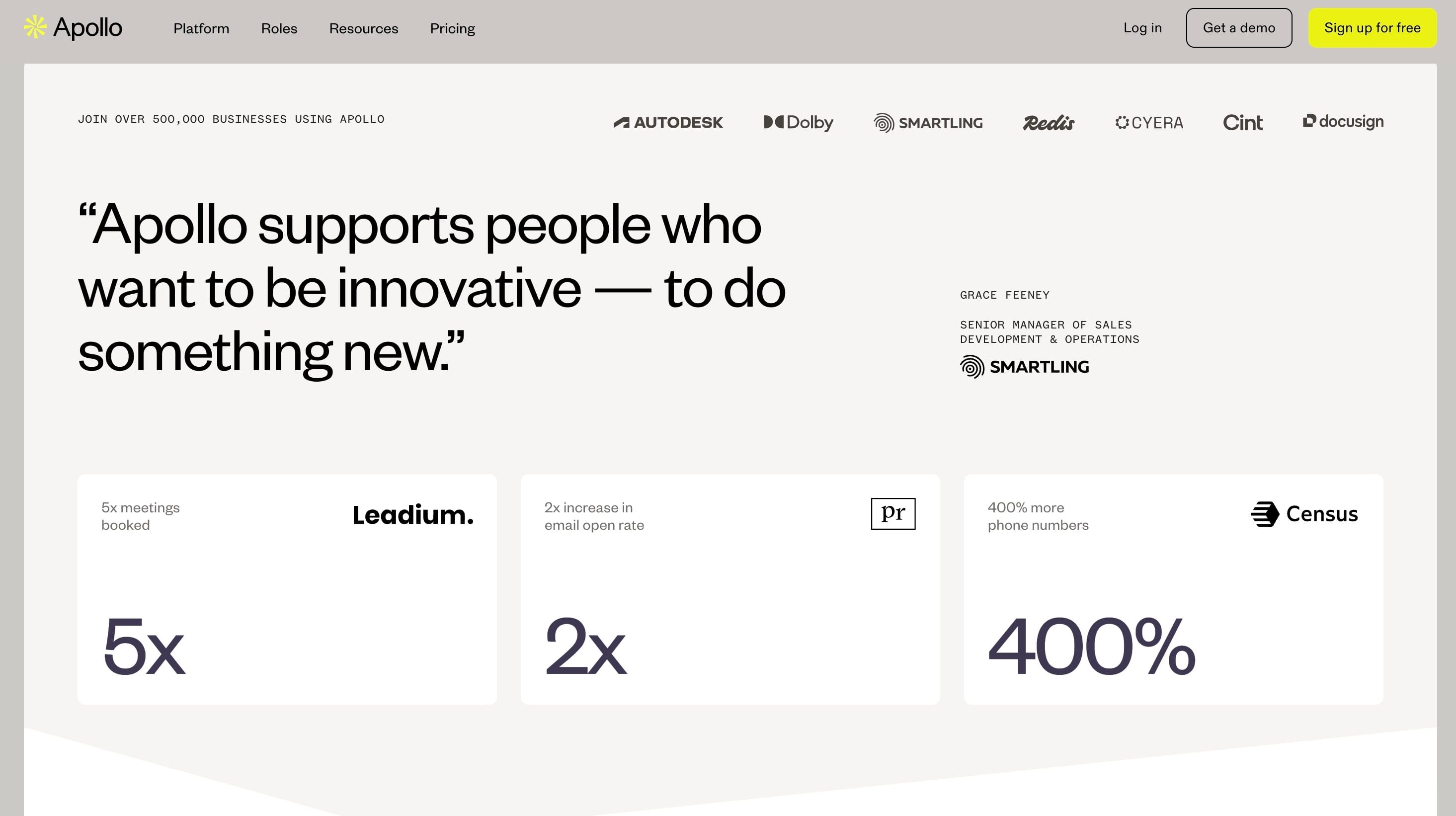
Apollo is a sales intelligence and engagement platform that combines a massive B2B contact database with multi-channel outreach tools. It’s designed to help sales teams build targeted lists, run automated campaigns, and qualify leads with rich behavioral insights.
Why Apollo Is a Good Choice:
Access to a database of 270M+ contacts with firmographic and technographic data.
Multi-channel outreach with customizable workflows (email, calls, LinkedIn).
Lead scoring and qualification based on behavioral signals.
Strong integrations with CRM systems to streamline data flow.
What To Look Out For:
Some data records may be incomplete or outdated.
Advanced features can be locked behind higher pricing tiers.
Pricing:
Free – $0/month
Basic – $49/user/month
Professional – $79/user/month
Organization – $119/user/month
13. Pipedrive – Visual Pipeline Management for SMBs
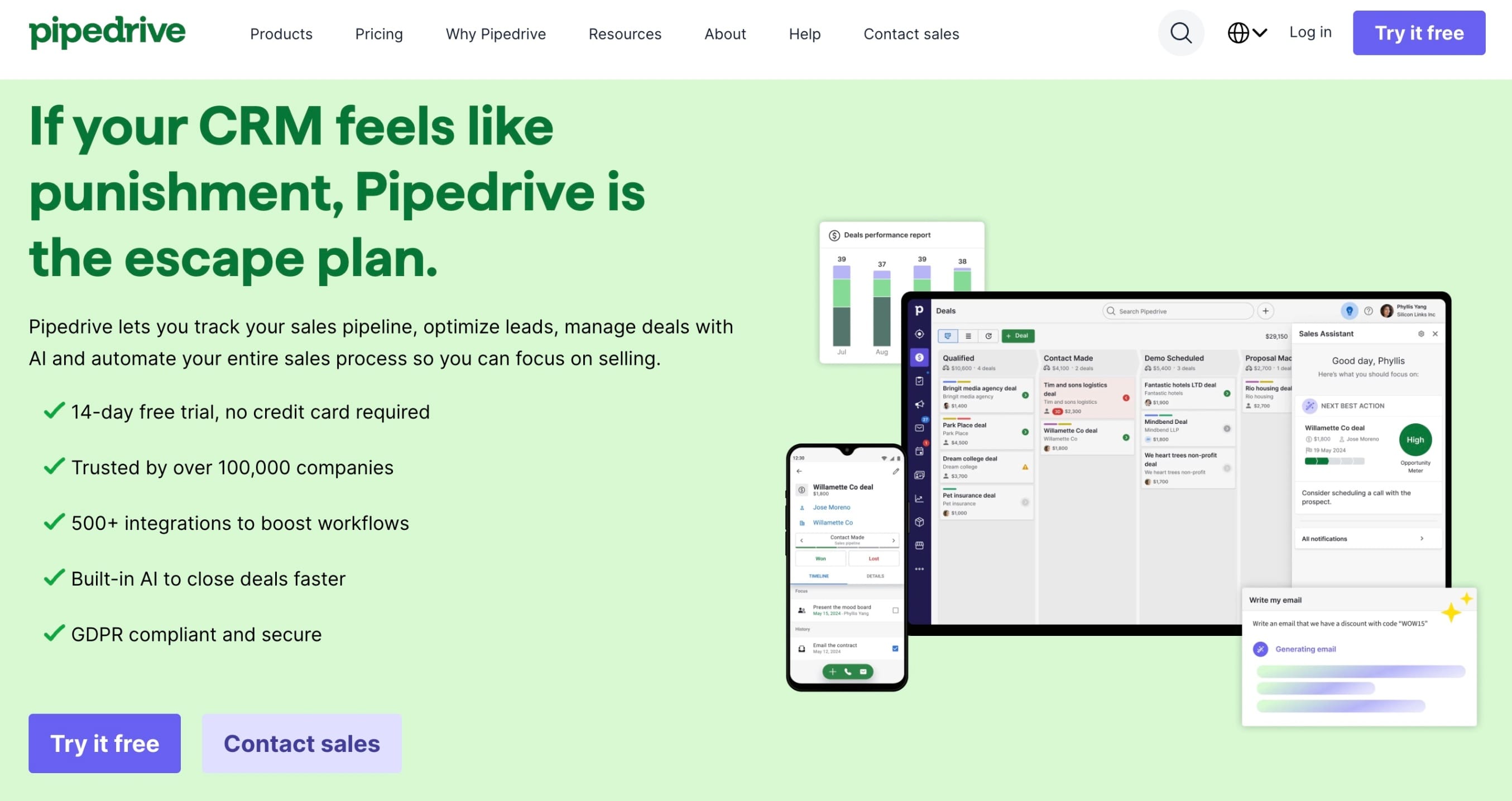
Pipedrive is a CRM built with simplicity and visualization in mind, making it ideal for small and medium-sized businesses. With its drag-and-drop pipeline interface, customizable workflows, and forecasting tools, Pipedrive helps sales teams stay organized and move deals forward efficiently.
Why Pipedrive Is a Good Choice:
Intuitive visual pipeline that makes deal tracking easy.
Customizable workflows and templates for different sales stages.
Forecasting and detailed reporting to monitor performance.
Affordable pricing suitable for growing businesses.
What To Look Out For:
Lacks some of the advanced enterprise-level CRM features.
Limited customization in lower-tier plans.
Pricing:
Essential – $14/user/month
Advanced – $34/user/month
Professional – $49/user/month
Power – $64/user/month
Enterprise – $99/user/month
14. Vidyard – Personalized Video Outreach for Sales
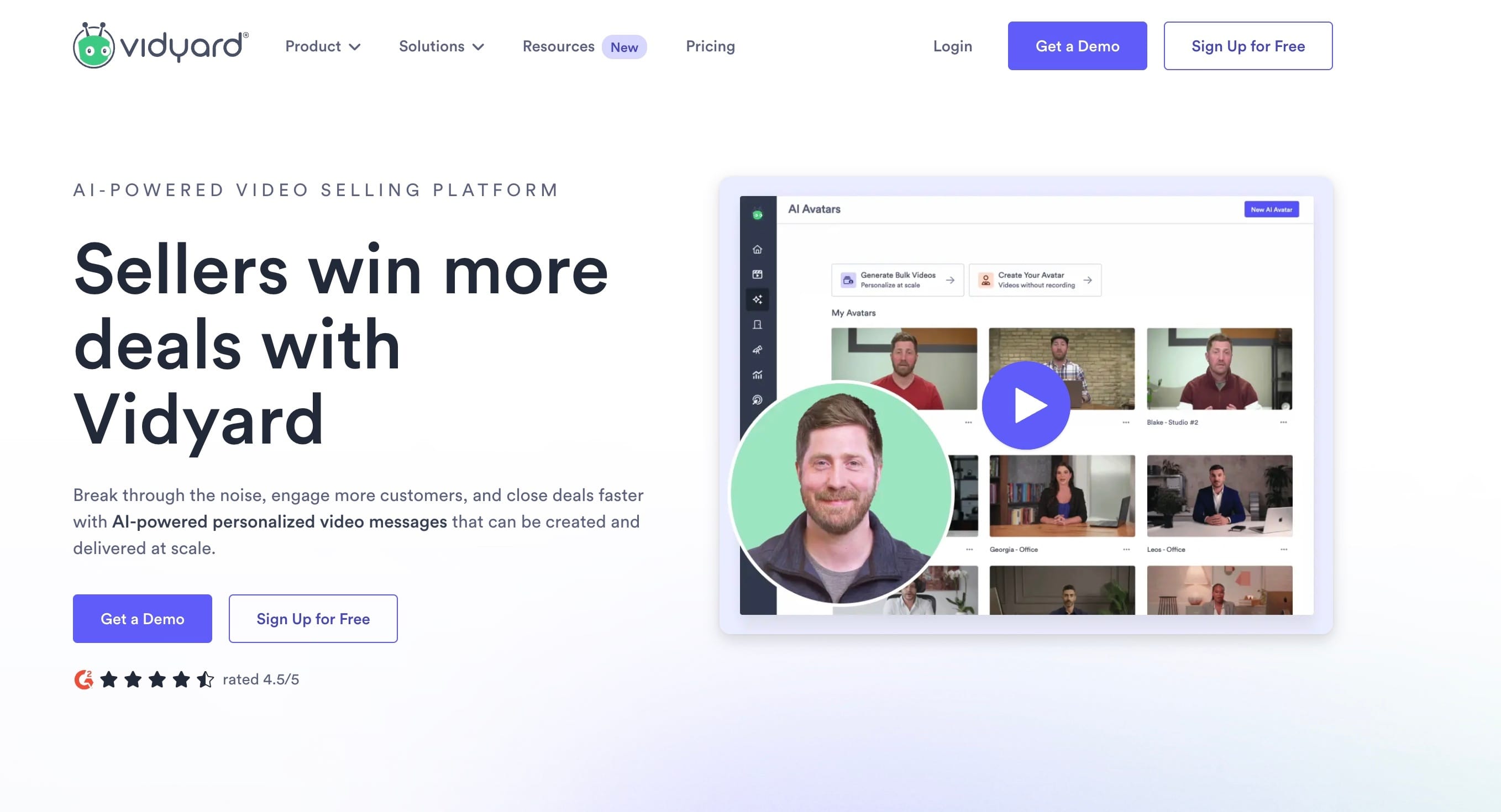
Vidyard is a video sales platform that helps reps stand out in crowded inboxes. It allows teams to record, share, and track personalized videos for prospects, making outreach more engaging and memorable. With built-in analytics, sales teams can see how leads interact with their videos and optimize communication.
Why Vidyard Is a Good Choice:
Enables personalized video messages to capture attention.
Engagement analytics show who watched and for how long.
AI-assisted tools for scripting and video creation.
Easy sharing through email, LinkedIn, or embedded links.
What To Look Out For:
Works best as a complement to other sales tools, not a standalone solution.
Advanced features are only available in paid tiers.
Pricing:
Free – $0/month
Plus – $59/user/month
Business – Custom pricing on request
15. Nextiva – Unified Communication for Sales Teams

Nextiva is a VoIP and communication platform that combines voice, video, and messaging into a single interface. It’s designed for sales teams that need reliable, real-time communication with prospects and smooth internal collaboration, especially in remote or hybrid environments.
Why Nextiva Is a Good Choice:
Unified platform for calls, video meetings, and team messaging.
Advanced call analytics and customer interaction tracking.
AI-powered call routing ensures leads reach the right team member quickly.
Scales well for distributed sales teams.
What To Look Out For:
Best suited for teams that rely heavily on phone and VoIP sales.
Extra features like advanced analytics may add to overall cost.
Pricing:
Digital – $20/user/month
Core – $30/user/month
Engage – $40/user/month
Power Suite – $60/user/month
16. Zoom – Reliable Video Conferencing for Sales
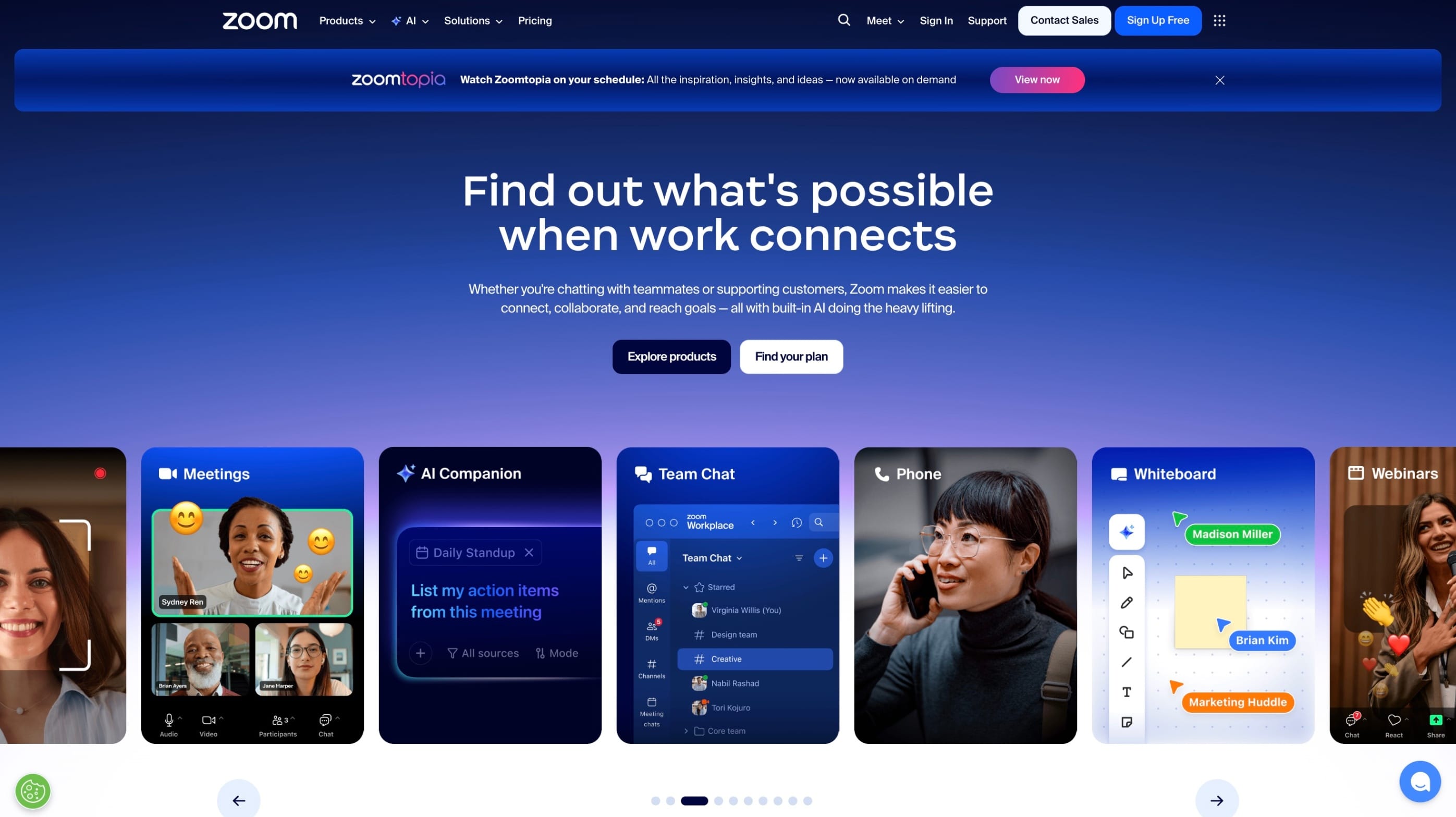
Zoom has become the standard for virtual sales meetings, demos, and webinars. Its simple interface and reliable video quality make it an essential part of the modern sales toolkit, especially for remote or global teams. While not a dedicated sales tool, it plays a vital role in connecting with prospects face-to-face.
Why Zoom Is a Good Choice:
High-quality video and audio for professional client meetings.
Screen sharing and collaboration tools for interactive demos.
Supports webinars and virtual events for lead generation.
Widely adopted and easy for prospects to join without friction.
What To Look Out For:
Webinar hosting and advanced analytics require paid add-ons.
Security and privacy settings need careful configuration.
Pricing:
Basic – Free plan
Pro – $13.32/user/month
Business – $18.32/user/month
Additional fees for webinars and advanced features
17. Calendly – Simple Scheduling for Sales Teams

Calendly eliminates the back-and-forth of scheduling by allowing prospects to book meetings directly on your calendar. It integrates with popular tools like Zoom, Salesforce, and Google Calendar, making it easier for sales reps to focus on conversations instead of logistics.
Why Calendly Is a Good Choice:
Automates scheduling with personalized booking links.
Syncs with multiple calendars to avoid double bookings.
Integrates with key sales and communication tools.
Helps reduce drop-offs by letting prospects pick a convenient time.
What To Look Out For:
Limited customization on the free plan.
Enterprise-level features can get expensive.
Pricing:
Free – $0/month
Standard – $10/user/month
Teams – $16/user/month
Enterprise – Starts at $15,000/year
Here's a round-up of everything covered as of now:
Tool | Core Strength | Best For | Cost Signal* |
|---|---|---|---|
SmartCue | Interactive, self-serve product demos | Presales + sales teams | Mid |
Salesforce CRM | Robust CRM with forecasting | Enterprise sales | High |
PandaDoc | Proposals & e-signatures | Closing deals faster | Low–Mid |
ZoomInfo | Verified contacts + intent data | Prospecting & lead gen | High |
Vivun | AI presales prioritization | Strategic deal teams | High |
Saleo | Live demo overlays | Product-led demos | Custom |
Mailsuite | Email tracking (opens, clicks) | Follow-up timing | Low |
Artisan | AI outbound automation | Outbound-heavy teams | Custom |
HubSpot CRM | Simple, user-friendly CRM | SMBs & startups | Low–Mid |
Zoho CRM | Affordable, customizable CRM | Cost-sensitive teams | Low |
LinkedIn Sales Navigator | LinkedIn prospecting | Account-based sales | Mid |
Apollo | Contact database + outreach | Lead gen at scale | Low–Mid |
Pipedrive | Visual deal pipeline | SMB sales tracking | Low–Mid |
Vidyard | Personalized video outreach | Cutting through inbox noise | Mid |
Nextiva | Unified voice, video, messaging | Remote/hybrid sales teams | Mid |
Zoom | Virtual meetings & webinars | Remote sales/demos | Low–Mid |
Calendly | Easy scheduling automation | Reducing booking friction | Low |
You Have the Tools, Now How to Actually Increase B2B Sales?
Having the best sales tools doesn’t guarantee closed deals.
The real challenge is moving leads through the pipeline efficiently, without losing them to delays, disengagement, or lack of urgency.
A structured sales pipeline is essential, but success depends on how well you execute each stage. At the top of the funnel, the primary objective is lead engagement. But with inboxes overflowing and buyers ignoring cold outreach, how do you capture attention and drive action?
Traditional sales motions, cold emails, gated content, or generic decks struggle to hold buyer interest.
Decision-makers don’t want sales pitches; they want instant clarity on whether your solution solves their problem. The best way to provide that? Let them have easy access to experience the product themselves.
Interactive demos allow prospects to explore key features of the proposal software, see the product in action, and understand its value, without scheduling a call or sitting through a static presentation. This accelerates qualification, making it easier to identify high-intent leads while reducing time spent on unqualified prospects.
The SmartCue Advantage: More Engagement, Faster Conversions
SmartCue transforms the initial funnel stage by:
Maximizing lead engagement – Buyers interact with guided product experiences tailored to their use case, making the solution immediately relevant.
Shortening the sales cycle – Leads arrive at discovery calls already familiar with the product, eliminating repetitive explanations and speeding up deal progression.
Improving conversion rates – Interactive demos pre-qualify leads, ensuring sales teams focus only on those with real buying intent.
With SmartCue, sales teams move beyond outdated engagement tactics and provide an interactive, on-demand product experience that drives pipeline efficiency and revenue growth.
Not sure how SmartCue fits into your workflow? Here's how you can create interactive demos that engage leads, shorten your sales cycle, and drive conversions in just a few minutes.
Step 1: Sign Up & Install the Chrome Extension
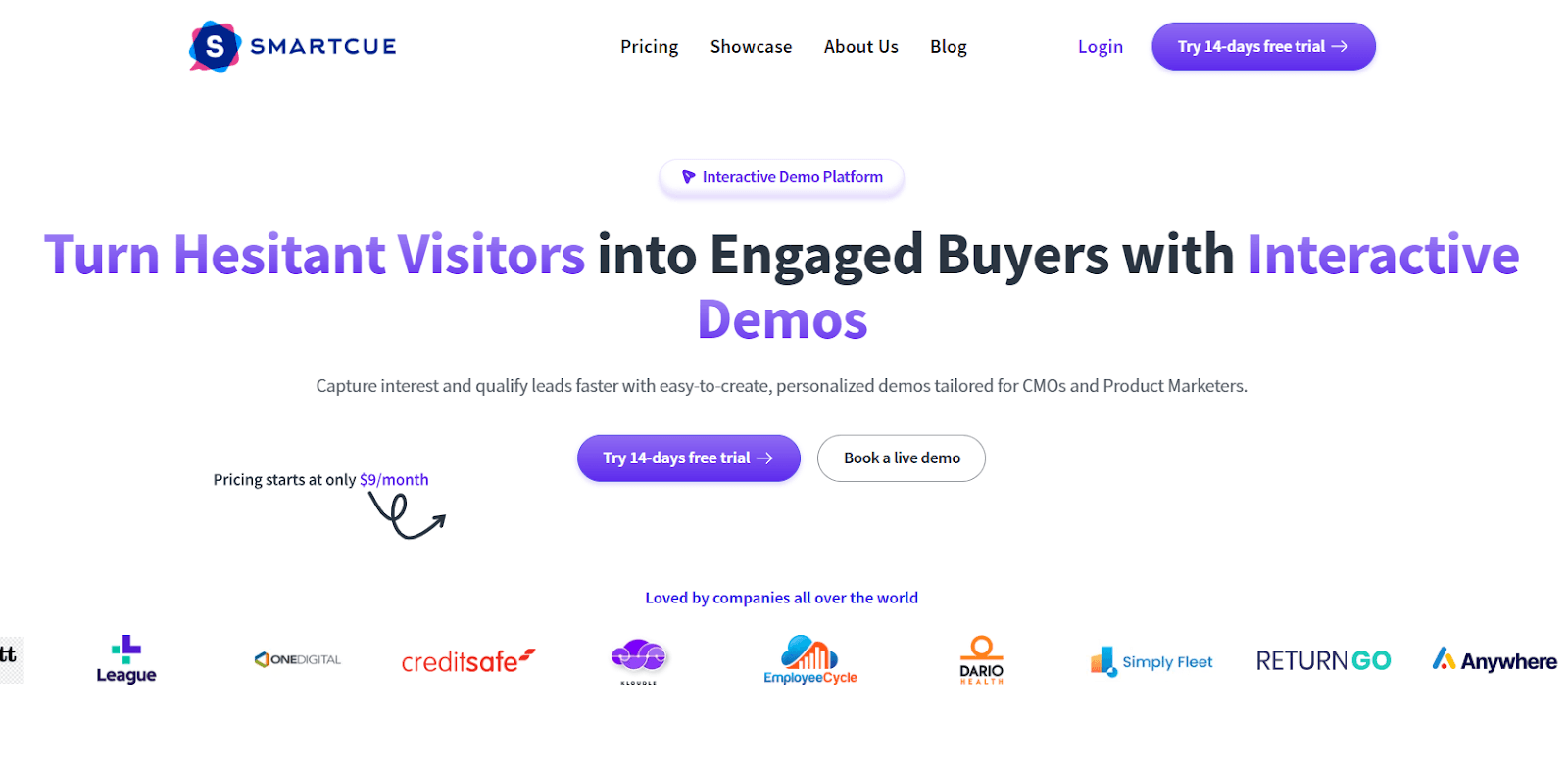
Get started with SmartCue’s free trial and set up your workspace in minutes.
Step 2: Capture & Build Your Demo

Use SmartCue to record your product walkthrough or start from a ready-made template.
Step 3: Customize for Clarity & Engagement
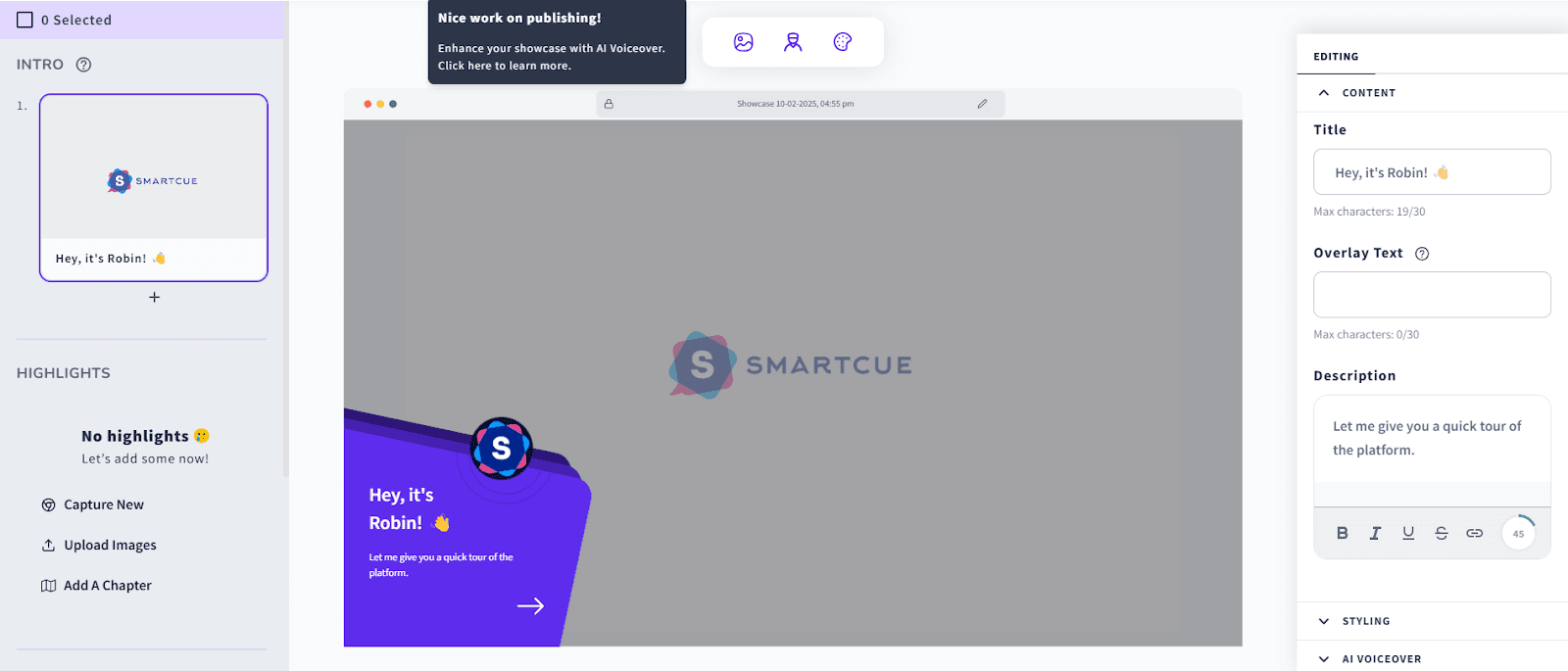
Add tooltips, text overlays, and interactive elements to guide prospects through your product’s value, without overwhelming them.
Step 4: Share & Track Engagement
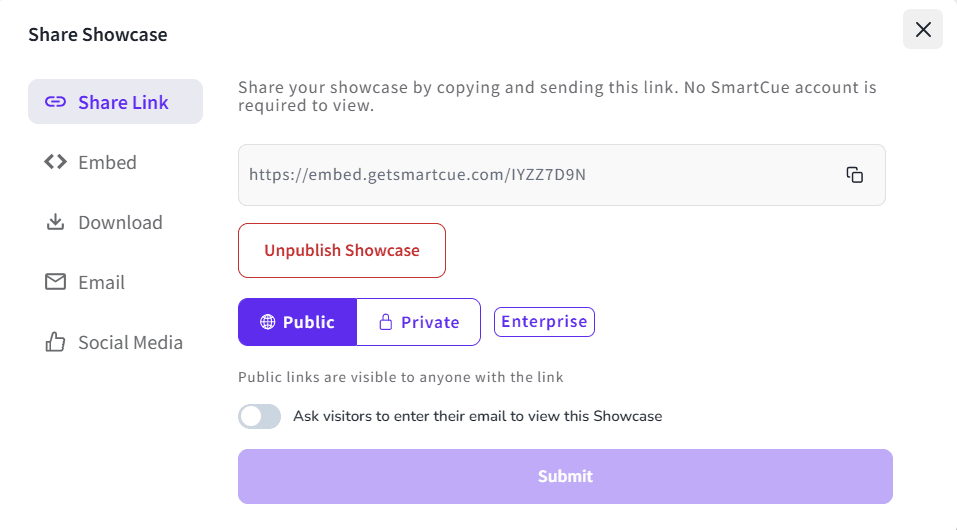
Send your demo link, then track which features prospects engage with the most, so you know exactly what resonates.
Frequently Asked Questions
What free B2B sales prospecting tools are available and which ones deliver real results?
Free plans from tools like LinkedIn Sales Navigator, Sales Cloud, and email tracking platforms give sales professionals access to lead lists, phone numbers, and email addresses. These prospecting tools with AI tools and social media insights help identify qualified leads and potential customers.
What features should I look for when choosing a B2B sales tool for my team?
The best B2B sales tools combine data enrichment, intent data, and sales automation. Look for CRM systems, customer relationship management integration, and sales enablement features like email tracking, marketing automation, and customer engagement support. A strong tech stack reduces repetitive tasks and drives sales performance.
How do popular B2B sales tools compare in terms of pricing and functionality?
Top B2B sales toolkit options vary widely. Some offer a free plan, while others like SmartCue, Sales Hub or LinkedIn Sales Navigator focus on premium features like job changes alerts, company size filters, and contact details. Compare automation, sales operations, and customer support to choose.
Are there any B2B sales tools that specialize in lead generation?
Yes, dedicated B2B sales enablement tools focus on lead generation by enriching contact information, email addresses, and LinkedIn profiles. They use AI tools, social media, and intent data to find potential leads. These are a great way to capture qualified leads efficiently.
What are the most recommended tools for B2B sales leaders to increase efficiency?
Sales leaders rely on the best marketing automation tools for B2B sales pipelines, LinkedIn Sales Navigator, and Sales Cloud. These streamline sales operations, automate repetitive tasks, and integrate with CRM systems. They’re part of a strong b2b sales toolkit improving customer engagement and sales performance.
Can you list the best B2B sales software options for 2025 that integrate with CRM systems?
Many sales automation platforms, like Sales Hub, offer seamless customer relationship management integration. These tools enrich contact details, automate follow-ups, and connect with LinkedIn profiles. This is a great way for sales professionals to manage potential customers and improve sales enablement in their tech stack.
Which tools are useful for tracking B2B sales performance?
Sales performance tracking often uses sales cloud dashboards, email tracking tools, and AI tools for data enrichment. With CRM systems and sales automation, sales professionals monitor customer engagement, lead lists, and company size segmentation, vital sales enablement metrics in the best B2B sales tools category.
Are there any up-and-coming B2B sales software platforms to watch in 2025?
Emerging B2B sales enablement tools blend intent data, social media insights, and AI tools. They simplify repetitive tasks, track job changes, and improve customer support. New sales automation software in 2025 will offer better contact information, LinkedIn Sales Navigator integrations, and more powerful marketing automation.
What are your go-to B2B lead generation tools and tactics?
Go-to tactics include leveraging LinkedIn profiles, email addresses, and phone numbers with data enrichment tools. Sales Navigator, CRM systems, and marketing automation platforms are a great way to build lead lists. Together, these best B2B sales tools turn potential leads into qualified leads.
What are the best practices for integrating new B2B sales tools into an existing workflow?
Best practices involve aligning the right sales tools with CRM systems and sales operations. Integrate sales hub, customer relationship management, and b2b sales enablement tools into your tech stack. Automate repetitive tasks, enrich contact details, and use marketing automation to drive customer engagement and pipeline efficiency.
Comments
Your comment has been submitted successfully!